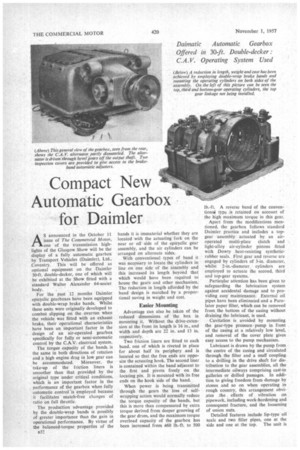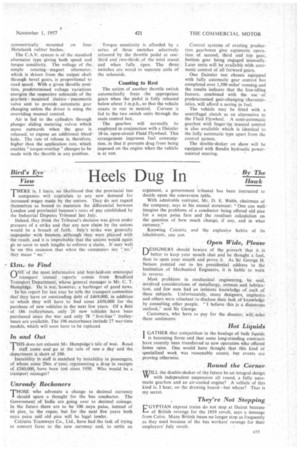Compact New Automatic Gearbox for Daimler
Page 70

Page 73

If you've noticed an error in this article please click here to report it so we can fix it.
AS announced in the October II issue of The Commercial Motor, one of the transmission highlights of the Glasgow Show will be the display of a fully automatic gearbox by Transport Vehicles (Daimler), Ltd., Coventry. This will be offered as optional equipment on the Daimler 30-ft. double-decker, one of which will be exhibited at the Show fitted with a standard Walter Alexander 64-seater
• body.
For the past 12 months Daimler epicyclic gearboxes have been equipped with double-wrap brake bands. Whilst these units were originally developed to combat slipping on the overrun when the vehicle was fitted with an exhaust brake, their operational characteristics have been an important factor in the design of an air-operated gearbox specifically for fully or semi-automatic control by the C.A.V. electrical system.
The torque capacity of the bands is the same in both directions of rotation and a high engine drag in low gear can be accommodated. Moreover, the take-up of the friction liners is smoother than that provided by the original type under critical conditions, which is an important factor in the performance of the gearbox when fully automatic control 'is employed because it facilitates snatch-free changes of ratio on full throttle.
The production advantage provided by the double-wrap bands is possibly of greater importance than the gain in operational performance. By virtue of the balanced-torque properties of the a32 bands it is immaterial whether they are located with the actuating fork on the near or off side of the epicyclic gear assembly, and the air cylinders can be arranged on alternate sides.
With conventional types of band it was necessary to locate the cylinders in line on one side of the assembly and this increased its length beyond that which would have been required to house the gears and other mechanism. The reduction in length afforded by the band design is matched by a proportional saving in weight and cost.
Easier Mounting Advantage can also be taken of the reduced dimensions of the box in mounting it. Without the drive-extension at the front its length is 16 in., and width and depth are 22 in. and 13 in. respectively.
Two friction liners arc fitted to each band, one of which is riveted in place for about half its periphery and is located so that the free ends are opposite the actuating hook. The second liner is contained within the band adjacent to the first and pivots freely on the locating pin. It is mounted with its free ends on the hook side of the band.
When power is being transmitted through the gears the loss of selfwrapping action would normally reduce the torque capacity of the bands, but this is more than compensated by extra torque derived from deeper grooving of the gear drum, and the maximum torque overload capacity of the gearbox has been inermed from 460 lb.-ft. to 500 lb.-ft. A reverse band of the conventionai type is retained on account of the high maximum torque in this gear.
Apart from the modifications mentioned, the gearbox follows standard Daimler practice and includes a topgear assembly actuated by an airoperated multi-plate clutch and light-alloy air-cylinder pistons fitted with ,Dowty heat-resisting syntheticrubber seals. First gear and reverse are engaged by cylinders of 3-in, diameter, whilst 2-in.-diameter, cylinders are employed to actuate the second, third and top-gear systems.
Particylar attention has been given to safeguarding the lubrication system against accidental damage and to providing easy maintenance. External oil pipes have been eliminated and a Purolator paper filter, which can be removed from the bottom of the casing without draining the lubricant, is used.
Cavitation is avoided by mounting the gear-type pressure pump in front of the casing at a relatively low level, and removal of the cover plate gives easy access to the pump mechanism.
Lubricant is drawn by the pump from the centre of the casing and circulated through the filter and a muff coupling to a drilling in the drive shaft for distribution to the gear assemblies, all the intermediate oilways comprising cast-in galleries or drilled passages. In addition to giving freedom from damage by stones and so on when operating in rough country, this arrangement obviates the effects of vibration on pipework, including work-hardening and consequent fracture, and the loosening of union nuts.
Detailed features include lip-type oil seals and two filler pipes, one at the side and one at the top. The unit is symmetrically mounted on four. Metalastik rubber bushes.
The C.A.V. system is of the standard alternator type giving both speed and torque sensitivity. The voltage of the simple rotating magnet alternator, which is driven from the output shaft through bevel gears, is proportional to road speed. With a given throttle position, predetermined voltage variations energize the respective solenoids of the gearbox mounted 'eleetro pneumatic valve unit to provide automatic gear changing unless the driver is using the overriding manual control.
Air is fed to the cylinders through plunger sliding metering valves which move outwards when the gear is released, to expose an additional bleed hole. The rate of release is, therefore, higher than the application rate, which enables " torque-overlap" changes to he made with the throttle in any position.
Torque sensitivity is afforded by a series of three switches selectively actuated by the throttle pedal at onethird and two-thirds of the total travel and when fully open. The three switches are wired to separate coils of the solenoids.
Coasting to Rest
The action of another throttle switch automatically frees the appropriate gears when the pedal is fully released below about 3 m.p.h., so that the vehicle coasts to rest in neutral. Current is fed to the two switch units through the main control box.
The gearbox will normally be employed in conjunction with a Daimler I8-in. open-circuit Fluid Flywheel. This arrangement improves fuel consumption, in that it prevents drag from being imposed on the engine when the vehicle is at rest. Control systems of existing production gearboxes give aqtomatic operation of second, third and top gear, bottom gear being engaged manually. Later units will be available with automatic control of all forward gears.
One Daimler test chassis equipped with fully automatic gear control has completed over 1,500 miles' running and the results indicate that the free-idling feature, combined with the use of predetermined gear-changing characteristics, will afford a saving in fuel.
The vehicle may be fitted with a centrifugal clutch as an alternative to the Fluid Flywheel. A semi-automatic gearbox with finger-tip manual control is also available which is identical to the fully automatic type apart from the control system. The double-decker on show will be equipped with Bendix hydraulic powerassisted steering.
























































































































